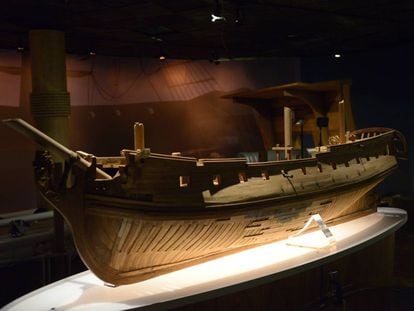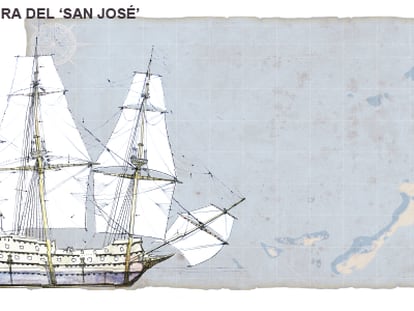Arqua, Spain’s underwater museum, has a problem with leaks
A Culture Ministry report is blaming faulty construction at the Murcia building, and warns there is little that can be done to stop sea water seeping in
/cloudfront-eu-central-1.images.arcpublishing.com/prisa/IPS3QOQ5TTBVAVMNPIA2X2GMPA.jpg)
Spain’s museum of underwater archeology, Arqua, has a water problem, and is going to have to shut down for six months for repairs.
Located in the port city of Cartagena, in the southeastern region of Murcia, Arqua holds a wealth of highly valuable maritime-related artifacts, including 600,000 coins from the Nuestra Señora de Las Mercedes, a Spanish ship that sunk in the early 19th century and that was at the center of a long legal dispute between the Spanish government and the US treasure hunter Odyssey.
Inaugurated in November 2008, Arqua is also home to the oldest known vessel in the world, a Phoenician ship dating back to the 7th century BC and found near Mazarrón, Murcia.
But the building has been experiencing damp and leaks in the basement, which is used to house exhibitions. A 2019 report by the Culture Ministry’s technical secretary for Infrastructure and Equipment, to which EL PAÍS has had access, describes a situation of “collapse” and suggests the need to create a maintenance protocol to deal with a problem that is threatening the future of the museum.

At the heart of the issue is the museum’s design and construction: the exhibition rooms were built more than four meters below sea level on ground that was reclaimed from the Mediterranean Sea. The original idea was to create a transparent floor that would allow visitors to see the seabed.
But this feature was never added, and instead, “the pressure exerted by the port’s sea mass” is causing leaks and creating “irreparable flooding” in the museum’s lower floor, according to the report.
Just a word
Carmen Jiménez, the deputy director general of Spain’s national museums, sought to play down the report’s use of the term “collapse.” “It’s just a word,” she said, adding that there has been constant maintenance work at the site and that there is no evidence that the objects on display have sustained any damage.
“It was a very delicate piece of construction work, but the facility is what it is, and now we have to apply solutions,” she added.
The most serious construction mistake flagged by the technician is in the 150-centimeter-thick concrete screens that were supposed to keep the underwater rooms watertight. Instead, seawater is filtering through cracks that should not have been there, the report notes.
The high humidity levels could be detrimental to the objects on display, says the report.
Arqua was built by the construction giant FCC and designed by the architect Guillermo Vázquez Consuegra, and came with a price tag of €20.3 million. According to the report, the damage is attributable to “the construction process,” which failed to make the building completely watertight.
A system was improvised to evacuate water through a network of drainage channels that surround the museum. But these have been blocked by the saltwater, and carbonic anhydride produced by the heating, ventilating and air conditioning systems keeps adding to the salt deposits, leaving the channels like clogged arteries. “It’s like blowing on the embers to rekindle a fire,” reads the report.

“The drainage system must have worked properly at the beginning, but shortly after the museum opened, dampness problems were detected in the basement floor, and eventually reached very high relative humidity levels that are detrimental to the conservation of the objects on display,” adds the study.
Costly repairs
Adding to these problems, the museum was built on a flat stone ground with no rainwater drains. As a result, whenever there are heavy rains the water accumulates along the building walls, and eventually leaks into the lower floor.

Repairs will cost around €280,000, and the basement exhibits will be transferred elsewhere while workers eliminate the salt deposits, among other tasks. But the technical report warns that the pressure from the sea will continue to cause leaks in the future.
In 2019 the museum had 107,407 visitors. Attendance figures have nearly doubled since Arqua was selected to house part of the Odyssey treasure.
English version by Susana Urra.












































